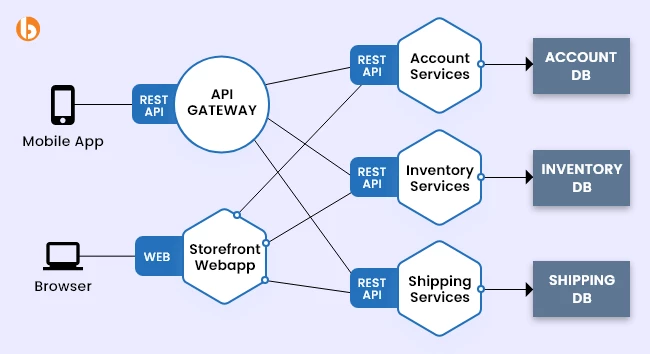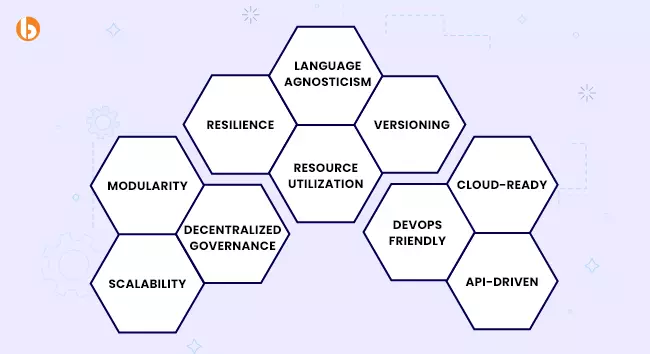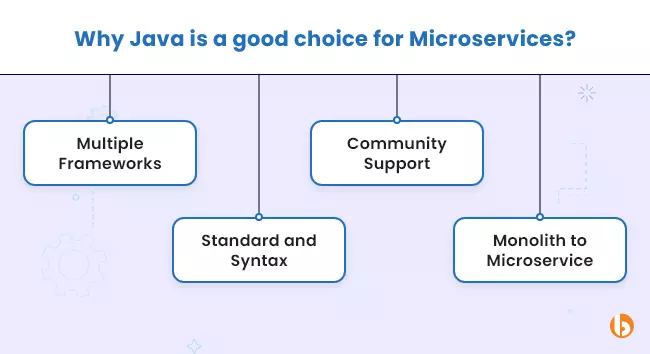Quick Summary:
In just a few years, microservice architecture has observed a significant upsurge within the web application development market. Many organizations, especially start-ups with complex implementations and integrations, are also shifting to microservices. However, the one programming language that has grabbed the most attention is Java microservices. This blog post has covered the all-around aspects of Microservices in Java, including its benefits, architecture, functionality, and a few Use Case Examples of Java Microservice.
Table of Contents
Introduction
Microservice Architecture is a new kind in the world of web application development. It has gained a lot of attention in recent times. According to a recent Survey in 2022, 85% of Companies are modernizing their applications to Microservice Architecture; around 56% of the organizations have a min. Half of their existing applications on microservices have observed release cycles that are daily and even more frequent. Complementing this, Java Microservices have kept a significant interest for the product owners and the business owners, but before going into the in-depth discussion, let us first understand What are microservices in Java.
What are Microservices in Java?
A Java application, when formed up by a set of independently composed, small, and lousely-coupled services, performs better and gains efficiency. These independent service units, functioning on their own without much hassle with the rest and the surroundings, are known are Java Microservices.
Microservices in Java or Java Microservices refers to the the traditional microservice architecture only, but as the barriers of the existing application do not restrict them; therefore, they are compatible with all the programming languages, which gives you the flexibility and scope for novel innovations and technologies and innovations and deploy them without hampering the other functioning of your application. Now that we have understood the Microservices in Java let us have a look at the Java Microservices Architecture

With the above-given microservice design patterns Java or microservices architecture Java we can understand how Java Microservices work. Thus, the Java Microservices architecture is not so different from the traditional microservice architecture. However, a few aspects must be understood before we draw a reason for the same. To realize that, let us move forward with our topic:
Benefits of Java Microservices
Java Microservices is an architectural pattern for microservices in Java programming language. It allows utilizing the benefit of the vast ecosystem of Java frameworks and the tool libraries that collectively work to deliver a better and bigger solution.
Less Complexity equals Lesser Issues
When you divide your application development process into smaller segments or services, the Complexity to implement is reduced equally. Every development team is free from the other teams’ dependency and will perform their own set of coding irrespective of the entire product. The microservice approach simplifies the complex segments of each service package. So, it becomes easy to create less complicated services than the whole application.
Isolated Success Approach
When one or more teams are working on a single application, it is always a risk to ensure the functionality of the whole application. However, with the microservice approach, every segment is divided into simpler components, each responsible for its part of the services, which assess the safety and the success of the application.
Scalability Improvement
No matter how clean and efficient your development process is, a bug or issue is always observed under all circumstances. However, finding bugs can sometimes be daunting if you plan to scale your application. Still, with the Java microservice approach, you can find those bugs or errors based on the service facing the issue, having troubles, or being not functional. Also, you can add or remove Java microservice packages per the company’s requirement when planning to scale your application.
Real-Time Processing
Continuous Testing and Deployment are an integral part of the development process within the Microservice approach. It allows you to process the service package in real time, and as soon as an error is found, the respective team works to update the service instead of the whole application. This side-by-side redressal or resolution of the problems makes real-time processing possible for the developers.
Rapid Deployment
Compared to the whole application development process, the Java microservice approach can be deployed and implemented in comparatively less time. The core reason is the time saved in finding and resolving the bugs, which is a daunting task in the traditional approach. As every service is developed and tested in real-time, as mentioned above, there is no gap for failure. The time saved can be a beneficial factor in helping market your application and deploy it in less time, which benefits the end customer, the company, and the business.
Multiple Teams Working Together Simultaneously
In the Java Microservice architecture, multiple teams work simultaneously in collaboration with each other; each team has its own set of ideas and mindsets as well as the way to implement a service within the microservice approach, all these ideas can be brainstormed and all the ideas can be accordingly and constructively implemented, this approach contributes to enhancing the productivity of the teams and improves professional coordination between them.
Want to build market-fit solutions yielding exemplary profits?
Hire Java programmer from us who are well-versed in using top ORM frameworks and have a solid understanding of server applications to uplift your app development process.
Reasons to Choose Microservices in Java Over Monolith
The decentralized architecture of Java Microservices is enough to benefit your web application development and update process under various aspects. However, let us consider why you should choose Microservices in Java for your web application in 2024.

Modularity
Designed as small, independent units that can be developed, tested, and deployed independently of one another.
Scalability
Can easily be scaled up or down to meet changing demand.
Resilience
These are typically built to be fault-tolerant and self-healing, meaning they can continue to function even if one or more services fail.
Decentralized Governance
Follow a decentralized architecture that allows for autonomy in deployment, scaling, and management.
Language Agnosticism
Can communicate with other microservices written in different programming languages.
Resource Utilization
Use fewer resources than monolithic architecture; thus, it is more efficient.
Versioning
This can support multiple versions of the same service, which allows for backward compatibility and easy rollbacks.
DevOps Friendly
Are designed to be easily integrated with DevOps tools and workflows, including automated testing and continuous deployment.
Cloud-ready
Can be easily deployed to a variety of cloud environments, including public clouds, private clouds, and hybrid clouds.
API-driven
API-driven facilitates internal and external communication between microservices and allows easy integration with external services.
Why Java is a Good Choice for Microservices?
When it comes to microservices, there are several tools, frameworks, and languages using which you can implement the microservice architecture. However, Java is among the top contenders that allow implementation of the microservice architecture. Let us have a look at a few reasons for this claim.

Multiple Frameworks
Java allows for several frameworks that enable microservice development as these frameworks make working with the microservices simple and fast. A few Java microservice widely used by developers for their development purposes are Spring Boot, Jersey, DropWizard, Spark, etc. These frameworks help simplify the configuration and setup process while assisting the developers in communicating between the microservices. There are various other publish and subscribe systems that help aid in the building of the microservice application.
Community Support
Java being so popular amongst developers, possesses a significantly large community accompanied by a wide assortment of resources, libraries, and frameworks. As Java is based on JVM allows you to develop many complex web applications worldwide and various other applications, including enterprise-grade applications, backend development, web applications, mobile, big data or cloud-based applications, AI, and scientific applications. Also, Java developers are easily and readily available possessing the required skill set for microservices as they understand the importance of microservices and are easily scalable, mainly used by organizations.
Standard and Syntax
Java possesses simple annotations that are developer-friendly and easy to read. Also, any Java EE standards support microservice architecture like JPA for data handling, JAX-RS for APIs, CDIs for managing components and lifestyle, and others. Java has become an ideal option for complex systems and implementations due to its simple readability. The Java application development is structured in a way that is designed to support the creation and implementation of microservices without any overhead.
Monolith to Microservice
As we know, the market worldwide is changing by the day; thus, the need to meet up with the changing trends of the market becomes a crucial issue. Many organizations, whether small or large, prefer implementing the latest market trends with the intent to meet up with modern-day challenges. But, adopting the said new technologies involves rewriting the entire application, which is not an applicable option as it requires investment in all terms, including time, resources, and cost to develop or the deployment of the large applications. Microservice architecture under these similar circumstances


Do you wish to scale your digital project on a tight budget?
Download & Preserve NOW, and Read LATER at your ease.
DownloadHow do Java Microservices Work?
Before we move further with Java Microservices, let us understand What is Microservice in general. Microservice Architecture or Microservices is an approach that involves the software development process to be done so that the software is segregated into several loosely coupled or small independent services that interact with respective well-defined APIs.
This allows for faster and more efficient development where multiple teams can work simultaneously on a particular application and deploy services independent of others. Now that we have recalled our knowledge of Microservices let us move forward with Java Microservices.
Often we come across the question What are Best Java microservice frameworks? To answer this common question, given below are several Java frameworks that assist in building exceptional Java microservices:
Spring Boot
Spring Boot is a renowned open-source Java framework allowing microservices to start small and iterate quickly. With the rising demand for open-source frameworks, corporations hire Spring developers to develop enterprise-level micro apps built within the spring boot ecosystem for a secure and efficient interface with source and consumer systems. Also, SpringBoot entails purpose-built features that aid in developing and implementing the microservices and scaling your project.
Jersey
It is a Java framework that simplifies the development of the REST web services and contributes to the communication layer between the microservices. This framework serves as a reference implementation of JAX-RS.
Swagger
It is a Java framework that allows for building APIs. It is a suite of tools that allows for standard documentation of the AP. Like Jersey, Swagger also can help with the communications layer between the microservices.
Java Microservices: Simple Tutorial
Here’s a simple tutorial to create a Java microservice using Spring Boot.
Step 1: Set Up Your Development Environment
Before you start, make sure you have Java 8 or higher and Maven installed on your machine.
Step 2: Create a New Spring Boot Project
Open your terminal and type the following command to create a new Spring Boot project:

mvn archetype:generate -DgroupId=com.example -DartifactId=my-microservice -DarchetypeArtifactId=maven-archetype-quickstart -DinteractiveMode=false
This will create a new Maven project with the Group ID “com.example” and Artifact ID “my-microservice”.
Step 3: Add the Necessary Dependencies
Open the pom.xml file in your project and add the following dependencies:

<dependencies> <dependency> <groupId>org.springframework.boot</groupId> <artifactId>spring-boot-starter-web</artifactId> </dependency> <dependency> <groupId>org.springframework.boot</groupId> <artifactId>spring-boot-starter-test</artifactId> <scope>test</scope> </dependency> </dependencies>
These dependencies will add the necessary libraries for creating a web application and writing unit tests.
Step 4: Create a REST Endpoint
Create a new Java class called “HelloController” in the src/main/java/com/example directory with the following code:

package com.example;
import org.springframework.web.bind.annotation.GetMapping;
import org.springframework.web.bind.annotation.RestController;
@RestController
public class HelloController {
@GetMapping("/hello")
public String hello() {
return "Hello, world!";
}
}
This code defines a REST endpoint at the URL “/hello” that returns the string “Hello, world!”.
Step 5: Run the Application
Open your terminal and navigate to the project directory. Type the following command to start the Spring Boot application:
This will start the application on port 8080.
Step 6: Test the Application
Open your web browser and go to http://localhost:8080/hello. You should see the message
“Hello, world!” displayed in your browser.
And this is how you’ve created a Java microservice using Spring Boot. You can continue to add more endpoints and functionality to your microservice as needed.
Java Microservices Example Use Case
There are a wide variety and types of applications that you can develop or scale your existing application to the new microservice architecture using Java microservices. Given below are a few of the top Java Microservice Use Cases that will help you to either scale your existing application or to build an efficient, effective, and fast, scalable application from scratch:
Modernization and Refactoring of the Legacy Applications
As we have mentioned before, the microservice architecture approach is ideal when you want an application that can offer a new and latest update per the market demands and the recent market trends without affecting the whole application. So, the microservice approach is the best possible solution; you get complete freedom to add additional features and functionalities to your existing application without hampering the other functionalities or the proper functioning of your application.
Applications Needing Extensive Data Management
When combined with the Event-Driven Architecture, Microservices become an ideal choice for building complex applications and cloud environments in many cases. It segregates data handling functionality in a compartmentalized manner, whereby they all have their own set of functionalities.
Real-time Data Processing Applications
When you are a business owner looking to build an application that needs real-time data processing, Java microservices are your ideal candidate. You can involve a number of microservices and thereby divide the data processing tasks into various segments, which further contribute to the application’s efficiency. The compartmentalized services would prevent the responses from being fetched from a lot of data and only from the required segment.
Multi-Group Application Development
With the changing market trends and demands for frequent changes within your application and to meet strict deadlines, the need for several developers working on the same piece of application’s feature is becoming common these days. Implementing the microservice approach within the development process would prevent future issues in the application merge as all these services would be separated into various independent segments and can be plugged in together by individual groups.
DevOps Model
DevOps acts as a companion to the microservice architecture, or we can say that with the combination of Java microservices and DevOps, you get the benefit of enhanced productivity of the development team by embracing a common toolset that you can use for development as well as operations. This practice allows for common terminology and processes for project requirements, task dependencies, and challenges, allowing both the developer team and the DevOps team to work together to fix a problem or build a configuration.
Conclusion
Java Microservices is an addition to the traditional structure of the microservices architecture whereby the approach is implemented using the Java programming language, as we have covered in the blog post. It would be best to look for various factors before going with microservices in Java. However, if you are a business owner looking to scale your web application or planning for an application that involves any of the above-given use cases, going with a microservice in Java is a feasible option. You can also Hire a Java Development Company like Bacancy, which would help you throughout your web application development within microservices Java.
Frequently Asked Questions (FAQs)
Yes, Java is great for microservices. It is easy to read and provides the functionality to work with complex systems. It has the annotation syntax, which in addition to the microservice framework, makes it even easier when powered by the microservice framework.
Microservices in Java communicate with each other via an inter-process communication protocol like HTTP message-based or event-driven communication patterns broadly classified into asynchronous and synchronous.
To test the microservices in Java, you should first separate and isolate the said services and perform the unit testing. One of the most preferred ways is to use the JUnit to test the microservices as separate units. Also, you can involve the DI in testing the services.
You can deploy the microservices in Java using either AWS or Docker by deploying the microservices on containers and can also implement the FaaS if needed.
Your Success Is Guaranteed !
We accelerate the release of digital product and guaranteed their success
We Use Slack, Jira & GitHub for Accurate Deployment and Effective Communication.






